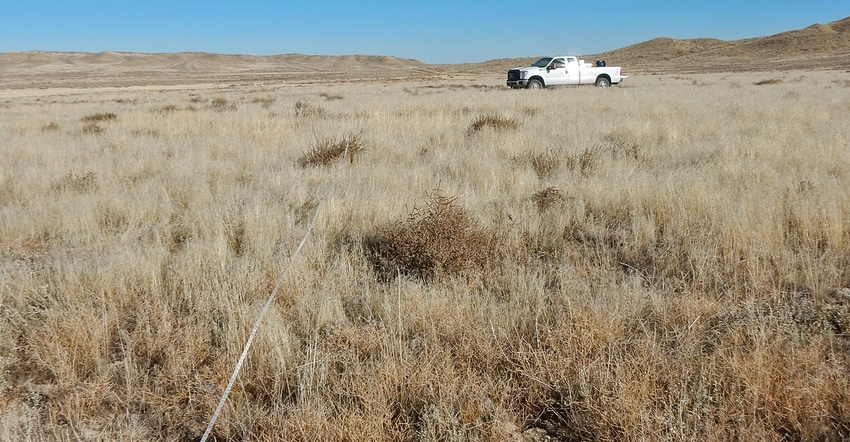August 15, 2017

Cheatgrass ranks on the top 10 list of prolific invasive plant species in the United States. Ranchers and wildlife managers dislike it for its short, annual lifecycle and low nutrient content. For the past 20 years, USDA Agricultural Research Service researcher Ann Kennedy of Pullman, Wash., has been conducting research on several strains of Pseudomonas fluorescens bacteria that inhibits cheatgrass growth and seed production.
The strain of Pseudomonas fluorescens labeled as ACK55, which also suppresses medusahead and jointed goatgrass, is currently under review for the bio-herbicide label by U.S. EPA.
“Pseudomonas inhibits the root elongation of the cheatgrass plants,” explains Aaron Foster, district supervisor of the Fremont County Weed and Pest Control District in Wyoming. “The roots weaken and can't get [take up] water and nutrients as well, so they’re much less vigorous and produce less seeds. This helps deplete the seed bank in the system and improve completion from desirables.”
Bacteria on the range
For success, Pseudomonas fluorescens must be applied in late autumn, when air temperature cools to below 50 degrees F, and rain and snow moisture infiltrate the bacterium into the soil surface. This establishes the soil bacteria to a high enough level to hamper cheatgrass growth in the spring. In the last four years, the Converse County Weed and Pest Control District of Wyoming has tested several strains of the bacteria.
“Over the course of the last 10 years,” says Cheryl Schwartzkopf, Converse County Weed and Pest district supervisor, “we treated over 150,000 acres of cheatgrass. We started out using just Plateau [herbicide], and now we are looking to add more tools to our toolbox for a more effective IPM [integrated pest management]. Combining low rates of Plateau and Pseudomonas fluorescens has shown positive results.”
Schwartzkopf says the Plateau herbicide knocks cheatgrass back the first year, allowing native bunchgrasses to begin re-establishing. As the Pseudomonas fluorescens bacteria grow in the soil, it stunts the cheatgrass and provides room for bunchgrass to continue to multiply. If native grasses and forbs are not present in a treated area, the desired plants need to be seeded — or else the cheatgrass control will be temporary. The optimal time to seed native plants is after bacteria application.
Once applied, the bacteria are active in the soil for four to six years. When Pseudomonas fluorescens is applied with Plateau herbicide, cheatgrass is immediately reduced. With solo application of Pseudomonas fluorescens, the cheatgrass is not visibly impacted for two to three years.
County-level research
Livestock grazing remains essential for cheatgrass control alongside the Plateau and Pseudomonas fluorescens. Grazing cheatgrass with livestock further stunts its growth and possible reseeding. At the same time, it’s important to not overgraze the native grasses, as they need to establish a healthier root system to fill in behind the cheatgrass.
“This spring we didn’t see as good results,” Schwartzkopf explains. “We had a lot of spring moisture, and so the cheatgrass is doing quite well this year. But the bio-control is still out there, and we have to be patient. Pseudomonas fluorescens is just like any bio-control; it's slow.”
Across the state in Fremont County, Foster took note of Schwartzkopf’s results. His trials evaluate the three Pseudomonas fluorescens bacteria strains for cheatgrass management.
“In 2015 we put out our first trial of MB906 near Lander,” Foster explains, “both individually and in combination with herbicide. In 2016 we applied more MB906 on private land in three different quadrants of the county. We’ve also applied two other strains, ACK55 and D7, on plots less than an acre. We have sample-point monitoring set up to monitor vegetation within the treatment, and a control outside of the treatment to see if there is measurable change with the bacteria over time.”
The ACK55 remains under review by EPA, but Verdesian Life Sciences’ D7 was registered in 2014 as a bio-herbicide. Foster has yet to observe reduction of cheatgrass in the treatment areas, but this should become evident in 2018, according to the forecasted two to three years.
“For now I don’t promote the bacteria,” Foster says. “I want see data that shows it's actually going to work. We are excited to get it out there so we can monitor it ourselves here in Fremont County.”
Foster also tracks Colorado State University’s research on indaziflam as a potential new herbicide for cheatgrass control. “The herbicide doesn’t allow cheatgrass to germinate for up to five years,” Foster says. “This slowly depletes the seed bank and allows the native perennials to flourish. The herbicide is currently used in the bare ground market, and is pretty expensive per acre at this point and experimental as a rangeland product."
Hemken writes from Lander, Wyo.
About the Author(s)
You May Also Like




